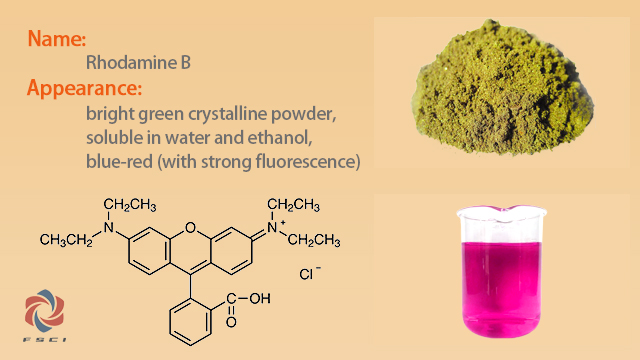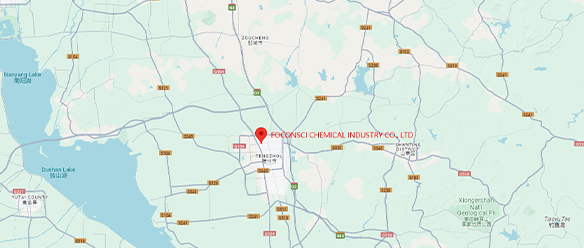Udredning af Rhodamine B: Et fleksibelt farvestof og dets tværgående anvendelser
Introduktion til Rhodamine B og dets vigtigste egenskaber
Rhodamine B (CAS 81-88-9 )er en lys rød farvestof, kendt for sin stærke fluorescensvirkning. Den bruges bredt inden for fluorescensmikroskopibilledgøring og detektering. Den er unik på grund af sin høj lysstyrke og stabile fluorescensemissionsegenskaber. Som en klassisk fluorescerende farvestof kan Rhodamine B binde til specifikke komponenter indenfor celler (som proteiner og nucleinsyrer) og udsende lys rød fluorescens efter eksitation, hvilket gør cellstrukturen og biologiske molekyler lettere at observere. Denne egenskab viser store fordele både ved billedgøring af levende celler og ved markering af fikserede celler. Den kan ikke kun hjælpe forskere med at identificere morfologiske ændringer i cellerne, men også spore de dynamiske processer af biologiske molekyler. Desuden giver den høje følsomhed hos Rhodamine B mulighed for fremragende billedgivningsresultater endda ved lave koncentrationer, hvilket er særlig velegnet til analyse af spormaterialer.
Rhodamine B i biomedical anvendelse

Inden for biomedicin tjener Rhodamine B som en effektiv sporermiddel og farvestof, hvilket giver forskere mulighed for at spore cellearbejder. Når det bruges sammen med chitosan (CAS 9012-76-4) , et naturligt polysaccharid kendt for dets biokompatibilitet, dannes der et lovende sammensætning til styrket medicinsk levering. For eksempel forbedrer Rhodamine Bs fluorescerende egenskaber Chitosan-baserede nanobærere, hvilket gør det muligt at overvåge præcist medicin i cellmiljøer – et afgørende faktor i kræftforskningsbehandlinger for at forbedre medicinmålretning og reducere bivirkninger.
Et andet værdifuldt sammensætning, Traneksamsyrlige Aci D (CAS 1197-18-8) , kendt for dets hudenlysningerseffekter, føjes ofte til hudplejeprodukter for at reducere pigmentation. I formuleringer, der omfatter både Rhodamine B og Traneksamsyre, hjælper Rhodamines intense farve med at vurdere visuelt distribution inden for kosmetiske baser, hvilket forbedrer konsistensen og kvaliteten af hudplejeformuleringer.
Tekstil- og industrielle farvestofanvendelser

Rhodamine B’s intense farve og fast farveegenskaber gør det til en foretrukken valg i tekstilindustrien, især for vibrerende stof der kræver varige farver. I tekstilapplikationer, methyl rød (CAS 493-52-7) —et pH-indikator og farvestof—kan bruges sammen med Rhodamine B for at justere farvetoner eller sikre kvalitetskontrol under farvebehandling. Methyl Red hjælper med at opretholde den optimale pH-lighed for at opnå den ønskede farvestyrke og -stabilitet.
For industrielle polymerer, azobisisobutyronitrile (AIBN, CAS 78-67-1) fungere som en polymeriseringsinitiativ, der komplementerer Rhodamine B’s farvestabilitet. I plastproduktionen bliver Rhodamine B tilføjet under AIBN-initierede reaktioner for at skabe varige, visuelt imponerende produkter. Denne anvendelse er almindelig i produktionen af farvede PVC-rør og -forbindelser, hvor modstand mod bleking ved lysudslag er afgørende.
Miljøanvendelser inden for sporring og vandbehandling

Rhodamine B spiller også en afgørende rolle i miljøstudier, især ved sporings af vandstrømninger. På grund af dets høje synlighed og opdagelighed bruges det ofte til at spore forureningsoptater i vandløb. I disse anvendelser, Kaliumbromid (CAS 7758-02-3 ) kan tilføjes som en ikke-reaktiv sporermiddel til måling af grundvandsbevægelser. Sammen med Rhodamine B og Kaliumbromid giver dette en omfattende kartografi af vandkilder, hvilket hjælper forskere med effektivt at spore forurenere.
I byggeri, Natriumglukonat (CAS 527-07-1) , et biodegraderbart betons tilføjningsmiddel, bruges ofte til bæredygtige vandstrømningskanaler. Dette materiale komplementerer Rhodamine B i jordinteraktionsstudier på byggepladser, hvilket understøtter udviklingen af miljøvenlige bygningsmetoder.
Konklusion og Produktanbefalinger
De unikke egenskaber ved Rhodamine B gør det højst tilpasligt i en række industrier, fra medicin til miljøvidenskab. Hvis du har brug for høj kvalitet kemiske produkter til at forbedre din formulering eller forskning, Foconsci Chemical Industry Co., Ltd. leverer højkvalitets produkter, der opfylder internationale standarder. Vores Rhodamine B (CAS 81-88-9) har fremragende fluorescens og stabilitet, egnet til farvning, sporingsformål og biomedicinske anvendelser. Desuden leverer vi også kemikalier såsom chitosan (CAS 9012-76-4) til biomedicin, methyl rød (CAS 493-52-7) til industrielle farvningsformål og kaliumbromid (CAS 7758-02-3) til miljøforskning.
For at få mere information eller placere en ordre, kontakt venligst Foconsci Chemical Industry Co., Ltd. for at udforske vores omfattende udvalg af kemiske produkter.
|
Kemisk navn |
cas Nej. |
Forhold til Rhodamine B |
Anvendelsesområder |
|
81-88-9 |
--- |
Fluorescensmikroskopi, biologisk forskning, miljøovervågning |
|
|
493-52-7 |
Kan kombineres med Rhodamine B til pH-indikatorer og farvestofkombinationer |
pH-indikatorer, farvestoffer, syre-base titration, farvestoffer |
|
|
9012-76-4 |
Chitosan membraner kan bære Rhodamine B til fluorescerende sensoranvendelser |
Medicinske materialer, fødevaretilsætningsstoffer, adsorbenter, lægemiddelbærere |
|
|
78-67-1 |
Som en fri radikalinitierer, bruges i polymeriseringsreaktioner til at forberede polymere, der indeholder Rhodamine B |
Polymeriseringsinitierere, skummedningsmidler, gummi, plastindustri |
|
|
1197-18-8 |
Er ikke direkte relateret til Rhodamine B, men kan kombineres med andre farvestoffer til hudpleje |
Blødstandsmidler, hudpleje, hvidnende ingredienser |
|
|
7758-02-3 |
Kan bruges med Rhodamine B som matrix eller hjælpeagent i spektralanalyse |
Spektralanalyse, medicin, optiske komponenter |
|
|
527-07-1 |
Er ikke direkte relateret til Rhodamine B, normalt bruges som en hjælpekomponent i andre felter |
Korrosionshæmmere, rengøringsmidler, fødevaretilsætningsstoffer, medicin |
|
|
Andre Kemikalier |
Kontakt os: E-mail: [email protected] |
||


 EN
EN
 AR
AR
 BG
BG
 HR
HR
 CS
CS
 DA
DA
 NL
NL
 FI
FI
 FR
FR
 DE
DE
 EL
EL
 HI
HI
 IT
IT
 JA
JA
 KO
KO
 NO
NO
 PL
PL
 PT
PT
 RO
RO
 RU
RU
 ES
ES
 SV
SV
 TL
TL
 IW
IW
 ID
ID
 LV
LV
 LT
LT
 SR
SR
 SK
SK
 VI
VI
 HU
HU
 TH
TH
 TR
TR
 GA
GA
 CY
CY
 KA
KA
 LA
LA
 MN
MN
 KK
KK
 LB
LB




